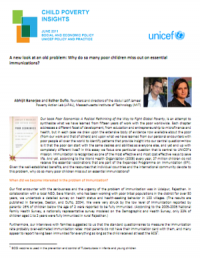Build it, and they will come?
The Global Alliance for Vaccines and Immunisation recently secured funding for the next four years, enough to immunise more than a quarter of a billion children in developing countries. This is estimated to save more than 4 million lives by 2015, which is clearly fantastic news. Vaccines are an incredibly cost effective way of improving and saving lives.
But what if they could be made even better?
 In a new UNICEF briefing paper Abhijit Banerjee and Esther Duflo describe their research in India with the NGO Seva Mendhir. They guessed that part of the problem was reliable service at government health centres. But that is only part of the story. Although poor people do spend substantial sums on healthcare, there is evidence worldwide of a lack of demand for preventative healthcare such as mosquito nets or chlorinated water, possibly due to the psychological/cognitive costs of implementing them (procrastination, inability to plan for or stick to a strict regime).
In a new UNICEF briefing paper Abhijit Banerjee and Esther Duflo describe their research in India with the NGO Seva Mendhir. They guessed that part of the problem was reliable service at government health centres. But that is only part of the story. Although poor people do spend substantial sums on healthcare, there is evidence worldwide of a lack of demand for preventative healthcare such as mosquito nets or chlorinated water, possibly due to the psychological/cognitive costs of implementing them (procrastination, inability to plan for or stick to a strict regime).
They tested this theory with a randomized experiment, and found that simple reliable service inrceased full immunization rates from 6% to 18%. However adding a small incentive (a bag of lentils) to do it now and combat procrastination, doubled full immunization rates again to 39%, and actually reduces the cost per immunization. Once a nurse's salary has been paid, its much more cost effective if she is kept busy.
The bottom line:
All in all, where valuable services are available but are not being accessed, policymakers should consider using small but salient incentives to increase immunization rates ... Governments often feel that they should first focus on strengthening supply, and only after this is done, start to worry about demand. It is clear that a minimum quality and reliability of immunization services is needed for any immunization program to work, but what the cost-benefit analysis of our experiment suggests is that working on the demand at the same time may increase cost effectiveness. Fifty-six dollars per fully immunized child is more than what most governments can afford, and more than what GAVI provides to eligible countries. However, $28 is much closer to what countries can afford. If demand can be strengthened, our experiment shows, households will walk the last mile: and it is much cheaper for the households to do so than for very well-paid nurses.











